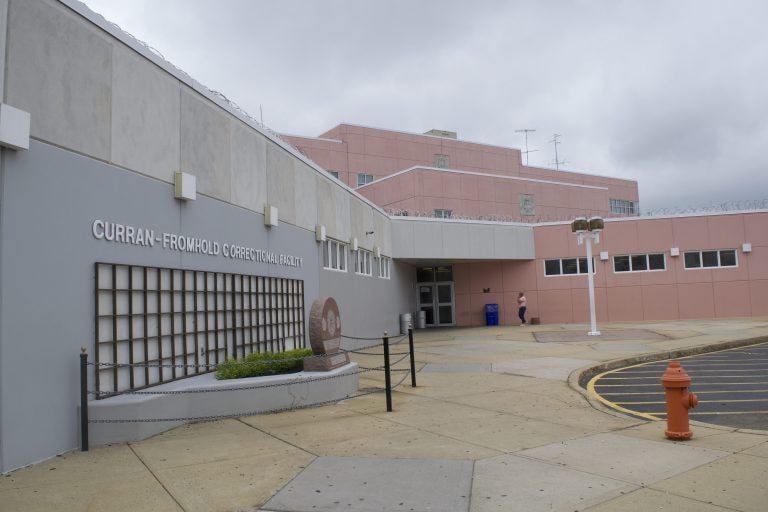Philadelphia Department of Prisons will begin offering buprenorphine to male inmates again
After months of searching for a doctor with the right waiver to prescribe Suboxone, the Philadelphia jail has solved the problem.

In January, medical officials at Philadelphia Department of Prisons were struggling to meet the demand for medication-assisted treatment among inmates as the result of federal prescription limits and unexpected staff turnover. Now, that problem has been solved. (Nina Feldman/WHYY)
After almost three months, the Philadelphia jail will begin accepting male inmates into its Suboxone program to treat opioid addiction. Admissions had stalled because doctors at the jail had reached the patient limit set by the federal government.
About one in every five inmates at the Philadelphia jail has opioid use disorder — on any given day, that’s about 900 people. For the Department of Prisons’ chief of medical operations, Bruce Herdman, those numbers offer an opportunity to get people on treatment while they’re incarcerated.
Suboxone, the brand name for the drug buprenorphine, is one of the three FDA-approved medications used to curb cravings and ease withdrawal symptoms for opioid use disorder.
The department started offering buprenorphine to its female inmates in February 2018 and expanded the program to men last summer. The jail became the largest provider of medication-assisted treatment in the city of Philadelphia, which has about 12,000 total slots for the treatment, 3,000 of which are available.
But in January, the jail’s program hit a snag. Doctors must go through special training to prescribe Suboxone, and, once they get that training, they can prescribe it to only a limited number of patients. Depending on a doctor’s specialty or the amount of time she’s been certified, that limit can range from 30 patients to 275. The department’s one board-certified addiction specialist with a waiver for 275 patients took another job in January, leaving the jail with more demand than doctors to prescribe the drug.
Officials spent two months scrambling to find a new addiction specialist to bring on board, but that proved challenging. Herdman thought he had secured a new hire, but it fell through at the last minute.
“There aren’t too many available,” he said of certified doctors. “So our one successful recruitment effort was interrupted.”
In the meantime, to continue complying with federal regulations, the jail had to stop admitting people to the Suboxone program. Herdman estimated that about 40 people a week were turned away.
Now, though, the problem has been solved.
The jail submitted an emergency application to the Substance Abuse and Mental Health Services Administration, the federal agency that regulates the waivers, requesting that one doctor’s waiver limit be expanded from 100 to 275 patients. The agency granted the application, and the jail will begin accepting men into its Suboxone program beginning Tuesday.
Demand for Suboxone treatment is roughly 400 people a day, Herdman said. In May, a number of Suboxone prescribers at the jail will reach the one-year mark, meaning their current 30-patient limits will increase to 100. That will offer what Herdman described as a long-term solution.
In tandem with solving the waiver issue for those receiving treatment while incarcerated, the department also has expanded its buprenorphine program for those leaving the jail. Beginning in mid-March, it started sending inmates home with at least five days’ worth of the drug itself, rather than prescriptions.
“It eliminates the barrier of having to go to a pharmacy to get the medication,” said Herdman. Prior to the change, records from the Pennsylvania Prescription Drug Monitoring Program indicated that about only 40 percent of people had filled their buprenorphine prescriptions in the community after leaving the jail.
Providing access to medication-assisted treatment for those leaving jail is particularly important because they’re at high risk for overdose death. Research has found that in the two weeks after being released from prison, people are 12 times more likely to die than the general population, with one of the leading causes of death being a drug overdose.
Because Suboxone curbs cravings, taking it upon release makes it less likely someone will seek out heroin or fentanyl. And, if someone were to use, having been treated with a low-grade opioid such as Suboxone while incarcerated would prevent tolerance from lowering completely, making an overdose less likely.
Herdman said sending people home with Suboxone instead of just a prescription will cost about $100,000, to be paid for by savings generated primarily from the decline in the incarcerated population. The current census at the jail is about 4,600 inmates, down from about 8,000 in 2015.
Beginning this week, department officials also will begin submitting applications on behalf of all inmates, men and women, to enroll them in Pennsylvania Medical Assistance, effective on the date of release.
Medical assistance is supposed to be suspended while someone is incarcerated and automatically reactivated when he or she is released, but Herdman said that process does not work reliably.
WHYY is your source for fact-based, in-depth journalism and information. As a nonprofit organization, we rely on financial support from readers like you. Please give today.




